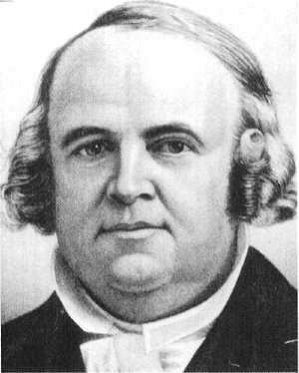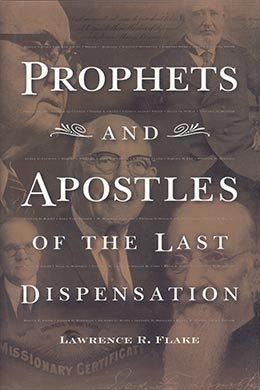Willard Richards
Lawrence R. Flake, Prophets and Apostles of the Last Dispensation (Provo, UT: Religious Studies Center, Brigham Young University, 2001), 247–49.

Born: 24 June 1804, Hopkinton, Massachusetts
Quorum of the Twelve Apostles: 14 April 1840 (age 35)
Second counselor to President Brigham Young: 27 December 1847
Died: 11 March 1854 (age 49), Salt Lake City, Utah
A year before his assassination, the Prophet Joseph Smith told his close friend and personal secretary, Dr. Willard Richards, that the time would come when balls would fly around Willard like hail, and he would see his friends fall on the right and on the left, but there would not be a hole in Willard’s garments. On 27 June 1844, Brother Richards, who had offered to die in place of the Prophet Joseph, was voluntarily imprisoned in Carthage Jail with Joseph, Hyrum, and John Taylor. Hyrum was the first to fall as a ball, fired through the panel of the closed door, struck him in the face. He fell to the floor exclaiming, “I am a dead man.” As the mob forced the door partly open, Brother Richards, with a walking stick, courageously parried off the muskets that were thrust through the opening. But his efforts were in vain. Next, his fellow apostle, John Taylor, was shot several times and bled profusely from the wounds. Then his beloved Prophet Joseph was shot and fell through the second story window into the midst of a howling, murderous mob. With no thought for his own safety, Brother Richards rushed to the window, determined to see the end of the Prophet he loved. Miraculously, in fulfillment of Joseph’s prophecy, Elder Richards was preserved without even a hole in his garments.
When word of the tragedy reached Nauvoo, Brother Richards had the formidable task of preventing war between the Saints and enemies of the Church. Along with John Taylor, who was recovering from his wounds, Brother Richards presided over the Church until the other ten apostles returned from their missions in the East.
As a young man in Massachusetts, Willard had been impressed that the true gospel of Christ would soon be restored to the earth. While practicing medicine near Boston in 1835, he opened a copy of the Book of Mormon and, after reading the profound doctrine of man’s purpose on the earth found in 2 Ne. 2:25–26, he declared that “either God or the Devil had had a hand in that book,” and he determined to find out which. He eagerly read the book twice in the next ten days and concluded, “God has something greater for me to do than peddle pills.” [1] Traveling to Kirtland, he was baptized by his cousin Brigham
Young and was sent on a mission to the East. Just one day after his return from his first mission, Willard started on a second, this one to England with six other elders, to introduce the gospel in that land.
Not long after their arrival, Elder Heber C. Kimball announced to Willard, who was thirty-three years old and still single, “I baptized your wife today.” The young lady, whom Elder Richards had never met, was Jenetta Richards, the daughter of a minister. The two became good friends, and one day he remarked to her what a fine name Richards was and said, “I never want to change it; do you, Jenetta?” “No; I do not,” she replied, “and I think I never will.” [2] They were married on 24 September 1839.
The following spring, while still in England, Elder Richards was called by revelation to serve in the Quorum of the Twelve (D&C 118:6). He was ordained by Brigham Young and became the first and only apostle ordained outside of the United States. Returning to Nauvoo in 1841, Elder Richards became general clerk of the Church, temple recorder, and secretary to Joseph Smith. During the exodus to the West and until his death in 1854, he acted as Church Historian. In Utah he was the first editor of the Deseret News and held several other important civil and ecclesiastical positions.
When Brigham Young became president of the Church at Winter Quarters in 1847, he chose Willard Richards as his second counselor. Elder Richards faithfully magnified that call until his passing six years later at the age of only forty-nine. Of him President Young said, “He was as true and unwavering in his course as the sun is to the earth. . . . There was not a shade of deviation . . . from the principles of righteousness.” [3]
Notes
[1] Claire Noall, Intimate Disciple: A Portrait of Willard Richards (Salt Lake City: University of Utah Press, 1957), 104.
[2] Orson F. Whitney, Life of Heber C. Kimball: An Apostle, the Father and Founder of the British Mission (Salt Lake City: Bookcraft, 1974), 143–44.
[3] Preston Nibley, Brigham Young: The Man and His Works (Salt Lake City: Deseret Book, 1974), 212.
